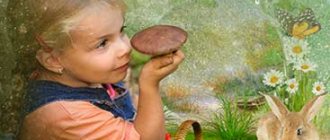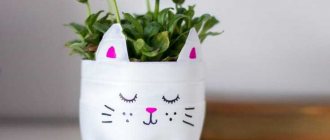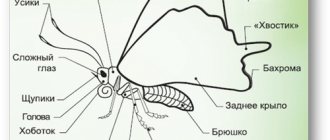Practice-oriented project “Plastic bottle - benefit or harm”
As a result of the walk, I realized that our native village has environmental problems that must be solved, otherwise the amount of plastic waste will only increase from year to year.
2.4. Experimental results
Next, I decided to check whether a plastic bottle really has such a long decomposition period. Of course, we cannot wait 500 years, but we can verify the information using a science such as chemistry. For help, I went to my chemistry teacher Lyubov Sergeevna Varfolomeeva. Together with her, after repeating the rules of work in the chemistry classroom, we conducted the following experiments (see Appendix 2).
Experience 1
Decomposition of substances under the influence of chemical reagents.
I placed fragments of a plastic bottle, nylon tape, and paper in a solution of sulfuric acid and sodium hydroxide (lye) and observed the result within a week. Five minutes after the start of the experiment, the process of decomposition of the nylon tape in a solution of sulfuric acid began. A week later, I saw that small grains of nylon remained in the sulfuric acid solution, and the paper crumbled into small pieces when stirred. In alkali, these fragments changed slightly. But the plastic did not change either in a solution of sulfuric acid or in alkali.
Conclusion. The experiment proves that a plastic bottle is not destroyed even by chemical reagents. Consequently, when they get into the ground, they will not decompose and rot, but will only litter the soil.
If plastic does not decompose in the ground, then perhaps it is safer to burn plastic bottles?
I have tested this experimentally.
Experience 2 . Combustion.
I took fragments of the same objects, burned them one by one and observed the result. The work was carried out in a fume hood with artificial draft. When burning fragments, I felt a pleasant smell of burnt feathers when burning paper, but a strong unpleasant odor and black smoke when burning plastic.
Conclusion: burning plastic bottles releases toxic smoke, which pollutes the air and has a negative impact on human health.
I made sure that plastic bottles should not be burned or thrown away.
Second life of a plastic bottle.
. Practical use of used bottles
While scientists are coming up with different technologies for recycling plastic containers, people are inventing their own ways to use bottles.
Birdhouses, mousetraps, funnels and seedling pots are made from bottles. They are hung on the fence as a scarecrow to keep crows away, and are also used as waterproof caps on the tops of posts. In Kazakhstan, washstands are made from plastic bottles, and in Indonesia, stabilizers are used to stabilize fishing boats. In Mongolia they are burned as sacrifices to spirits. In third world countries, where ordinary European dishes and containers are rare, plastic containers are in significant demand. In Ethiopia, used bottles are sold directly in markets. In African countries, sandals are made from flattened one and a half liter bottles.
Research work “The second life of a plastic bottle”
Irina Shokhalevich
Research work “The second life of a plastic bottle”
Relevance of the study : The plastic bottle has become a very strong part of our lives and is easy to use. of plastic bottles is increasing every year . The number of landfills to which used plastic bottles . A large amount of garbage on the streets of our village, in the forest, ravines, and roadsides made me think about the question: what can be done to reduce the harmful effects of plastic bottles on the environment ?
The problem of the study is the contradiction between the positive properties of plastic bottles and its negative impact on nature.
The purpose of my research : to identify the conditions and methods of recycling plastic bottles .
I set myself the following tasks:
1. Study the history of the origin and use of plastic bottles .
2. Develop ways to combat plastic waste.
3. Involve village residents in the problem.
Object of study : unnecessary plastic bottles
Subject of research : the possibility of recycling plastic bottles .
Hypothesis: suppose that if we use what lies under our feet in landfills, then people will cause less harm to nature.
Research methods :
— study of literary sources;
- sociological survey;
— observation.
plastic bottle first appeared on the US market in 1970. In Russia, plastic bottles Coca-Cola entered the soft drink market.
and PepsiCo.
The first plant for the production of lemonade in plastic bottles in the USSR was opened
in 1974 in Novorossiysk.
The advantages of plastic bottles are numerous : they are light, transparent, and can be painted any color if desired. SLIDE
Plastic bottles, unlike glass ones, do not break and are easy to transport. The big disadvantage of plastic bottles is the difficulty in recycling and disposal .
In today's world, recycling of plastic waste is not developed in all countries. For example, in Russia only 3% of solid waste is subject to industrial processing ; the rest is disposed of in landfills.
The share of plastic waste is growing year by year at an alarming rate. It is already known that there are five garbage patches in the World Ocean, formed as a result of the accumulation of waste. This can cause irreparable environmental damage, as plastic waste causes the death of a huge number of marine life.
These landfills cause enormous harm to nature and human health.
Considering the fact that plastic waste rots from 200 to 1000 years, one can imagine with horror that our planet may soon turn into a huge garbage dump.
To better understand the extent of human use of plastic bottles in our village , I decided to visit a number of stores. a lot of plastic bottles in grocery stores. Kvass, lemonades, vegetable oil, sauces, ketchups, dairy products, mineral water, seasonings - this is an incomplete list of products that people most often buy in a plastic bottle . At the hardware store I also saw a considerable list of goods packaged in plastic containers : shampoos, conditioners, liquid soap, detergents and cleaning products, windshield wipers, etc. I saw plastic bottles at the pharmacy : baby bottles , sippy cups, oils, shampoos, many medicines are also packaged in plastic bottles .
Having finished my shopping trip, I came to the conclusion that the stores in our village sell a lot of food and goods in plastic containers .
In order to assess the ecological state of our village, I took a walk through the streets. Along the roads and near some houses I came across plastic waste . SLIDE
As a result of the walk, I realized that our village has environmental problems that need to be solved, otherwise the amount of plastic waste will only increase from year to year.
Next, I decided to conduct a test among classmates and third grade students to find out how often they buy food and goods in plastic bottles and where they put unnecessary bottles . SLIDE
Test results showed that all respondents regularly buy food and goods in plastic bottles . Most often, unnecessary plastic bottles are thrown into a landfill, some burn bottles , there are also those who use unnecessary bottles in everyday life : they plant seedlings in them, make various useful crafts, use them as containers for non-food products, etc. This method of using used plastic bottles I really liked it. An unnecessary bottle in the hands of skillful owners becomes a necessary and useful thing.
So, what can be done to ensure that there is plastic waste in garbage heaps as possible?
I have discovered many sites where people share their bottle .
Bottles are an environmentally friendly solar water heater SLIDE
A Chinese farmer placed 66 bottles on the roof of his house, connecting them with a simple system of tubes. Bottled water heats up almost instantly and enters the house. There is enough hot water for three members of an enterprising Chinese family to take a hot shower. The neighbors liked the invention so much that they decided to use this idea.
Fantastic plastic boat SLIDE
A team of French explorers is planning to sail from San Francisco to Australia (18,000 km)
on an 18-meter vessel made entirely of
plastic bottles (except for sailing masts)
.
The construction of the yacht took 16,000 two-liter plastic bottles , which are filled with dry ice (to give hardness)
.
A million bottles for the construction of a temple SLIDE
That's exactly how many bottles the environmentally conscious Buddhist monks of Thailand used to build their temple. During the construction of the temple, the monks used green and brown beer bottles . In the temple, even toilets and crematoriums are made from empty bottles .
February 28, on the Sportivnaya embankment in Vladivostok “bloomed”
pancake trees.
Such a miracle arose thanks to volunteers. In honor of Maslenitsa, the children hung huge pancakes on the branches. The traditional Maslenitsa dish was “cooked”
from plastic bags.
We collected a bunch of bags that pollute our planet and made pancakes out of them
using an industrial hair dryer, giving them the slightly uneven shape of real culinary products. The pancakes were then painted yellow-brown. 20 people worked on the project for three weeks .
Full of ideas, I decided to create something from plastic bottles with my own hands . He also decided to organize a competition in the classroom “ The Second Life of Plastic Bottles ”
. The children, together with their parents, took an active part in the competition and created a lot of useful and beautiful things from unnecessary material.
The research allowed me to learn a lot of new and useful things about plastic bottles . I found out when and where the first plastic bottle . I found out what environmental problems are associated with the use of plastic packaging . I studied the environmental problems of our village. In order to attract others to the problem, I organized a competition in the classroom for crafts made from plastic bottles, “ The Second Life of a Plastic Bottle. ”
.
I put forward at the beginning of the study was confirmed. The ecological state of our village is in danger, but it can be improved by reducing the amount of plastic waste . To do this, you need to learn how to properly handle unnecessary plastic waste .
My research allowed me to make our home a little cleaner and more beautiful. After all, plastic bottles that were supposed to go to the trash pit were given a second life .
My observations have shown that if you approach this problem creatively and economically, you can find many ways to use plastic packaging . Each of us can contribute to solving this issue.
It’s not without reason that people say: “It’s not where they clean, but where they don’t litter” that’s clean.
.
Sunflower from plastic bottles
A beautiful craft - a second life for a plastic bottle and concern for the environment. An unusual and attractive sunflower can be made using plastic blanks of various colors: light brown or yellow and green. They are manufactured as follows:
- First, the bottom and neck of the bottle are removed, and the resulting plastic cylinder is cut lengthwise to form a rectangular sheet.
- A square is cut out of it.
- The corners of the square are cut off to form an octagon.
- Slots are made on each side using scissors, and then sunflower petals are formed, rounding them on both sides. You will need 2 of these blanks.
- The leaves are cut out from a green bottle: from a square you need to make a base with four petals.
- Then you need to singe the edges of the petals over a lighter. But the middle should not be deformed, so you need to place a coin in the center of the base and hold it while heating with tweezers or pliers.
- All parts of the product are connected to each other with plastic glue, and the center of the flower is decorated with dark beads or seed beads.








